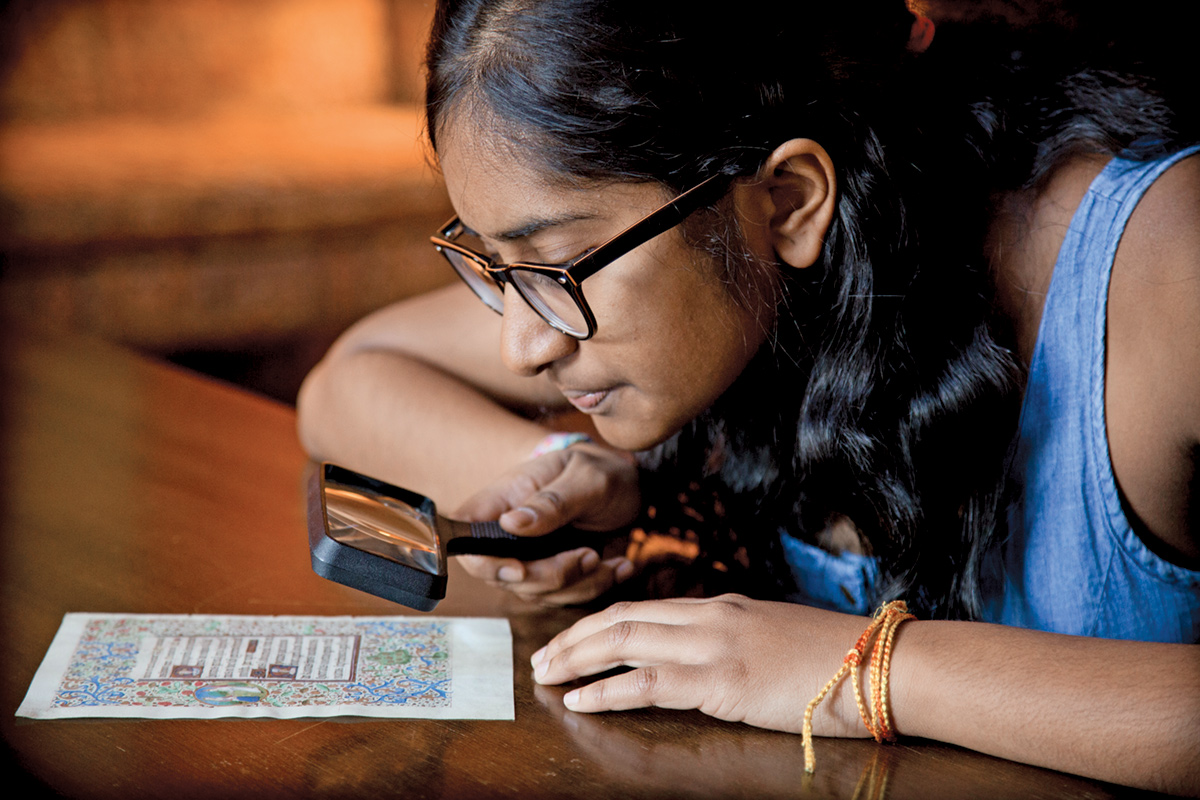Proof Points
Making research second nature for undergraduates

Ann Borden
“The definition of marriage cannot be disputed. It’s right there in black and white, and it’s been the same since the start of Wikipedia.”—Jesse Tyler Ferguson, star of ABC’s Modern Family
The world rains information, yet it’s possible to die of thirst awaiting that one, true thing: reliable evidence.
Given the ease of online research and the sometimes spotty education in scholarship techniques that students receive during high school, they can struggle in this arena. But as a research institution, Emory creates opportunities for undergraduates to conduct research alongside faculty, which means that they must know—or quickly learn—how to use primary evidence.
Students generally know how to classify sources like Wikipedia, but the paved road to credible scholarship may end there. What are the best practices undergraduates should follow in gathering and analyzing different viewpoints or in judiciously weighing evidence and comparing ideas? Does a ‘balanced judgment’ simply mean presenting competing claims? How do different disciplines approach evidence?
Enter SACSCOC—a mouthful as acronyms go, but the guide that has helped lead Emory first-year education to an exciting new place. That knot of letters stands for the Southern Association of Colleges and Schools Commission on Colleges, and it is Emory’s accrediting body. As part of the accreditation process, schools that fall under SACSCOC need to institute a Quality Enhancement Plan (QEP) as a requirement for reaccreditation, a process in which Emory is currently engaged. SACSCOC describes a QEP as “a carefully designed and focused course of action that addresses a well-defined topic or issue(s) related to enhancing student learning.”
There is wide latitude in what schools can choose for their QEPs. At Rice, it was community-based research in Houston (led by Dean of Emory College of Arts and Sciences Robin Forman when he was there); at Auburn, an e-portfolio project; at Duke, a project on world citizenship; and at Clemson, a plan to improve students’ critical thinking skills.
Emory’s plan is called The Nature of Evidence, and it was first conceived in fall 2011, when a two-year process of planning, soliciting proposals, and engaging in broad-based discussion across campus boisterously began. Four final topics were proposed, all of which played to Emory’s strengths: primary evidence; worldview (international); sustainability; and engaged scholarship, learning, and service.
Many conversations later, primary evidence held sway as being most germane to Emory’s goals and mission as a liberal arts research university. It was agreed that students should graduate with an appreciation for the difference between a 1963 newspaper article and a Wikipedia entry; between a study published in a scientific journal and a newspaper article about new findings; between an ancient text and a book interpreting an ancient text; between an original painting and a picture of a painting.
Big ideas need powerful engines, and Pamela Scully’s roars. Chosen by the provost in early 2013 as chair of the QEP Development Committee, Scully is the director of the Center for Faculty Development and Excellence (CFDE), assistant vice provost for academic affairs, and professor of African studies and women’s, gender, and sexuality studies. For Scully, the most rewarding part has been the organic process and consistent collaboration.
“The QEP Development Committee included faculty from all the schools, including Oxford, as well as students, administrators, and alumni. The topic developed naturally as part of this inclusive process,” Scully says. “Discussion continued with the University Senate, the Faculty Council, Emory College faculty, the Academic Affairs Committee of the Board of Trustees, and all the schools. A special student group gave feedback and designed a QEP T-shirt. I and my colleagues could not have received better help and inspiration than the whole of Emory offered.”
The Nature of Evidence has three components that span the first-year experience at Emory. It is designed to engage students both in and outside the classroom through an introductory orientation, classroom instruction, and cocurricular experiences. The goal, Scully says, is that students will finish their first year understanding the building blocks of knowledge and engaged by the opportunities Emory offers as a liberal arts research university.
Faculty involvement is key to The Nature of Evidence. The CFDE will form academic learning communities on the subject of evidence in order to develop a campuswide conversation about teaching evidence to students. At summer workshops, faculty experienced in teaching evidence will train other faculty. Common approaches to teaching evidence will be developed, but faculty will have flexibility in their courses to teach and evaluate evidence in ways appropriate to their discipline.
One approach to fostering engagement will be the Evidence-in-Action program, which will ask first-year students to attend four events, including an Encounter with Evidence talk and three electives. The latter are opportunities for first-year students to attend discussions in the professional schools and learn about work at places such as Yerkes National Primate Research Center; the Manuscript, Archives, and Rare Book Library; and The Carter Center.
Encounter with Evidence talks will involve presentations by two faculty members demonstrating the ways that evidence is identified and used in their fields. For example, how would a chemist and an art historian work with the same shard of ancient pottery?
This past March, the SACSCOC review team visited Emory, and is now preparing its report for submission to SACSCOC. The organization’s Board of Trustees will meet in December to take final action on Emory’s reaffirmation.
In the meantime, the Emory implementation team is working, with pilot programs planned for the 2014–2015 academic year and a “proper rollout,” in Scully’s words, in 2015–2016.
View The Nature of Evidence report online.
The QEP formally will extend five years, but Scully and her many collaborators are confident that The Nature of Evidence will create an “evidence community” at Emory to further energize the university’s already thriving, dynamic culture of research.



